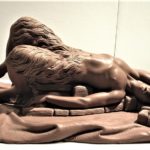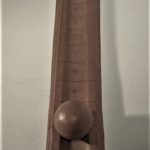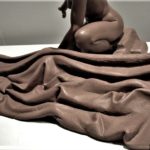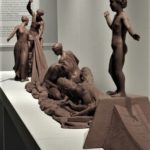
Scultura in terracotta cm.470 x 80, progettata nel 1998 per il Giubileo del 2000 al Pantheon di Roma.
Attualmente proprietà del Gruppo Cremonini, esposta allo spazio Trevi museo Città dell’acqua a Roma.
Terracotta sculpture 470 x80 cm designed in 1998 for the Jubilee of 2000 at the Pantheon in Rome
Currently owned by the Cremonini Group on display at the Trevi space, Città dell’acqua Rome
TEORIA DEL SACRO . La via dell’acqua
lunghezza cm 460. altezza cm. 76,5. profondità cm. 60
Progettata nel 1998 e realizzata nel 1999 per essere esposta all’interno del Pantheon in occasione del Giubileo del 2000, la scultura rappresenta la religiosità nell’essere umano dagli inizi fino al nostro millennio ed è ispirata alla classicità del mondo antico, visto che il Pantheon prima di essere una Basilica Cristiana era un Tempio Pagano.
L’opera vuole esprimere l’iniziale forza del paganesimo, il suo declino, la sua fine con la rappresentazione della morte del Dio Pan ( il Dio caprino, simbolo della forza della natura, che successivamente presterà le sue sembianze al Demonio del Cristianesimo) per continuare poi tramite la presenza di un Gesù che invita a proseguire nel futuro il passaggio dal Paganesimo al Cristianesimo.
Il concetto globale di tutta la composizione prende ispirazione dalle sculture di Fidia al Partenone, dove le figure assecondano l’ inclinazione della architettura.
In questo caso non esiste architettura ma strutture geometriche astratte, un primo grande triangolo, che inizia dalla mano alzata del centauro fino alla sfera alla fine della composizione, un secondo triangolo dal Centauro alla figura morta del Dio Pan e, un terzo triangolo delineato da Gesù alla Sfera… tre triangoli simbolo della Trinità
Le figure del secondo triangolo non vogliono essere contenute da una architettura reale, ma vogliono mostrare un andamento decrescente, simboleggiare cioè una decadenza progressiva e la fine, ossia la morte del Dio Pan, del Mondo Pagano.
Il centauro Chirone ( il più famoso dei Centauri e, che per la leggenda insegna agli uomini la adorazione degli Dei) passa alle Moire ( Cloto, Lachesi e Atropo ) il filo del destino, che loro stesse hanno realizzato e che Atropo poi avrebbe reciso, questo lungo drappo composto da tanti fili, quindi tanti destini, è modellato in modo quasi surreale per alludere ad un torrente d’ acqua che scorre come un fluire del tempo, come una via d’acqua simbolo di vita e purezza.
Le Moire hanno sulla testa un copricapo, il quale, progressivamente nel corso della decadenza del Mito, rivela il viso e gli occhi: la luce, la rivelazione di Dio.
Atropo è distante da Pan, e ne anticipa la morte con la tristezza del suo corpo.
Mentre tutta la composizione della scultura è fatta per una visione prevalentemente frontale, in questo caso esiste anche una vista laterale che crea un effetto di prospettiva,(guardando le due figure da un punto preciso tra la piramide e la sfera) nel quale Atropo è vicina a Pan per offrire in modo delicato una sua attenzione sessuale, perché la forza della natura sopravvive alla morte.
Un mito che muore….. ma anche un mito che si trasforma e continua
Della piramide a tre lati (simbolo della Trinità), Gesù è il vertice: un Gesù adolescente che indica i tempi prima e dopo di lui.
Una struttura di moderna sobrietà suggerisce un tempo e un percorso lineare, dove una sfera (simbolo di perfezione, cioè DIO) lascia una impronta concava e imprime in ogni secolo il segno della croce, sostando nel millennio del Giubileo.
Opera esposta nel 2004 al Museum Carolino Augusteum di Salisburgo (Austria).
E al Museo Ca’ La Ghironda di Zola Predosa (Bologna)
THEORY OF THE SACRED. The way of water
Kjii length 460 cm. height cm. 76.5. depth cm. 60
Designed in 1998 and built in 1999 to be exhibited inside the Pantheon on the occasion of the Jubilee of 2000, the sculpture represents religiosity in the human being from the beginning until our millennium and is inspired by the classicism of the ancient world, given that the Pantheon before being a Christian Basilica it was a Pagan Temple.
The work wants to express the initial force of paganism, its decline, its end with the representation of the death of the God Pan (the goat God, symbol of the force of nature, which will later lend its appearance to the Demon of Christianity) for then continue through the presence of a Jesus who invites us to continue the transition from Paganism to Christianity in the future.
The overall concept of the whole composition takes inspiration from Fidia’s sculptures in the Parthenon, where the figures follow the inclination of architecture.
In this case there is no architecture but abstract geometric structures, a first large triangle, which starts from the raised hand of the centaur up to the sphere at the end of the composition, a second triangle from the Centaur to the dead figure of the God Pan and, a third triangle outlined by Jesus to the Sphere … three triangles symbol of the Trinity
The figures of the second triangle do not want to be contained by a real architecture, but they want to show a decreasing trend, that is to say to symbolize a progressive decline and the end, that is the death of the God Pan, of the Pagan World.
The centaur Chiron (the most famous of the Centaurs and, which according to legend teaches men the adoration of the Gods) passes the thread of destiny to the Moires (Cloto, Lachesis and Atropos), which they themselves created and which Atropos later would have cut, this long drape made up of many threads, therefore many destinies, is modeled in an almost surreal way to allude to a torrent of water that flows like a flow of time, like a waterway symbol of life and purity.
The Moires have a headdress on their heads, which, gradually during the decline of the Myth, reveals the face and eyes: the light, the revelation of God.
Atropos is distant from Pan, and anticipates his death with the sadness of his body.
While the whole composition of the sculpture is made for a mainly front view, in this case there is also a side view that creates a perspective effect, (looking at the two figures from a precise point between the pyramid and the sphere) in which Atropos is close to Pan to delicately offer her sexual attention, because the force of nature survives death.
A myth that dies… .. but also a myth that transforms and continues
Of the three-sided pyramid (symbol of the Trinity), Jesus is the summit: an adolescent Jesus who indicates the times before and after him.
A structure of modern sobriety suggests a time and a linear path, where a sphere (symbol of perfection, that is GOD) leaves a concave imprint and imprints the sign of the cross in each century, stopping in the millennium of the Jubilee.
Work exhibited in 2004 at the Carolino Augusteum Museum in Salzburg (Austria).
And at the Ca ‘La Ghironda Museum in Zola Predosa (Bologna)
Roma
Antonio Sgroi in mostra a “La città dell’Acqua”



